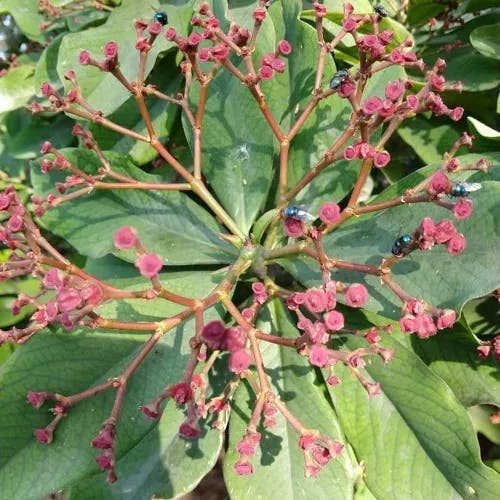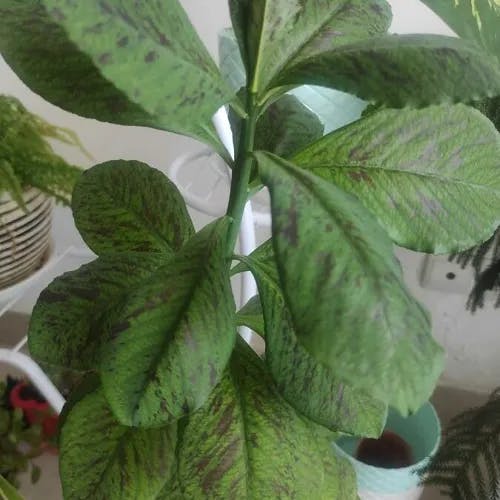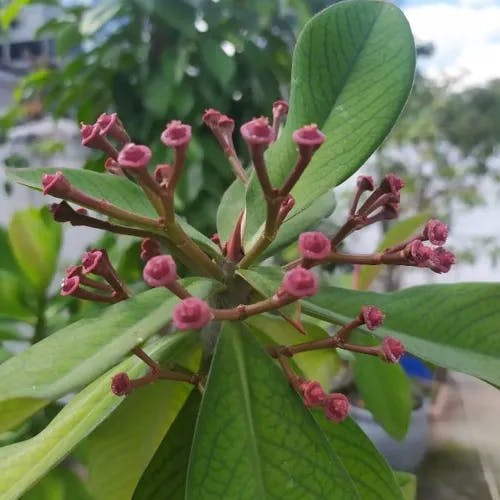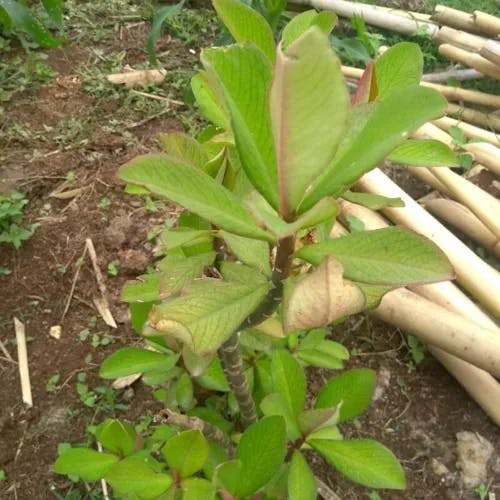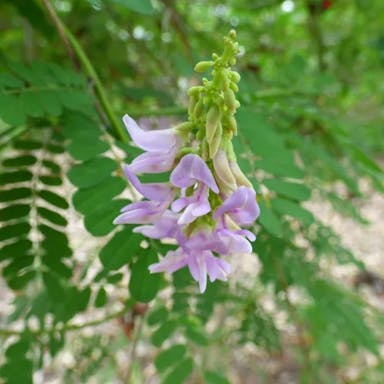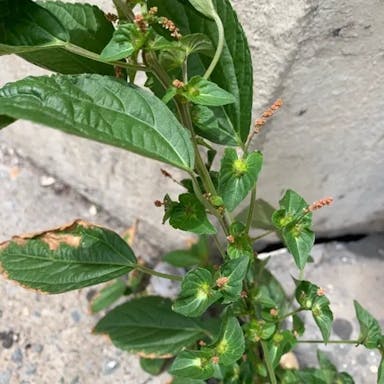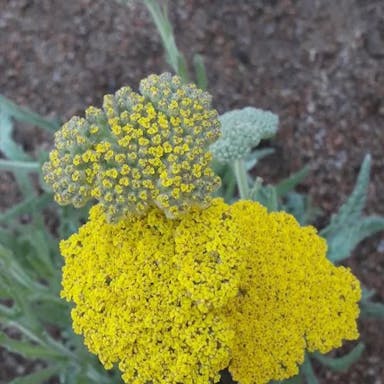The plant generally named African milk bush has scientific title Euphorbia umbellata belonging to the Euphorbiaceae family. This species is local to Africa, noticed often in nations as South Africa, Mozambique, Zimbabwe. Distinguished by its fleshy stems, leaves storing water for aridness. Little inconspicuous flowers of E. umbellata are yellow or green, clustered in umbel pattern. Surrounded by showy red, pink or white leaf-like bracts. An attractive perennial surviving over two years. Well-liked decorative plant given unique visual and simple care. Reaching three feet tall, spreading stems and leaves. Making fruits with seeds. Relatively simple cultivation needing drainage, moderate water. Tolerating variety of hot or humid temperatures. Caution required handling the sap causing irritation if contacted or toxicity if consumed.
African milk bush
- Scientific name
- Euphorbia umbellata
Basic Information
- Euphorbiaceae Family Euphorbia Genus African milk bush Species
- Euphorbiaceae > Euphorbia > Euphorbia umbellata
- 83%
- The Completeness of This Encyclopedia
Please help us complete the encyclopedia, Terrarium is a encyclopedia service to be completed with everyone in the world. Currently, this page is 83% complete. For more information on how to contribute, please click here.
- Forb/herb
- Height
- Flower Color
- Leaf Color
- Anthesis
- Sunlight Exposure
Full Sun Long hours of sunlight from morning to afternoon Partial Shade A location in the shade of a tree or where either the morning or afternoon is shaded Full Shade A place where there is no direct sunlight
- Hardiness Zones
This is an indicator to know to which zone each plant can winter. Knowing the zone of each plant gives you an idea of the cold temperature resistance when grown in the ground without a roof. 2: -42.7 to -40.0 3: -39.9 to -34.4 4: -34.3 to -28.9 5: -28.8 to -23.3 6: -23.2 to -17.8 7: -17.7 to -12.2 8: -12.1 to -6.7 9: -6.6 to -1.1 10: -1.0 to 4.4 11: 4.5 to 10.0
- Cold resistance
- Heat resistance
- Habitat of origin
- Growth Rate
What is African milk bush (Euphorbia umbellata)?
What is African milk bush (Euphorbia umbellata)
Flower meaning
American speech of posies offers no defined connotations for the tall columns of African milk bush, botanically termed Euphorbia trigona. Though this resilient succulent of unique milky sap lacks flowers, its endurance symbolizes the hardy spirit's strength. Neglect leaves it thriving, unlike delicate blooms cherished for intricate nurturing rituals. Unlike fragile petaled beauties, this stark sapling survives harsh climes with minimal provision. Such stoic vegetation suits spartan surroundings, making it beloved by devotees of interior greenery for its unfussy constitution. Undefined by the lexicon of covert floral messages, this hardy succulent signals its own significance through stalwart survival of inhospitable habitats.
Calendar of African milk bush (Euphorbia umbellata)
Calendar
African milk bush, called Euphorbia trigona, came from Africa. People grow it inside homes in America. Its flowers time changes based on care and conditions. It generally flowers during spring and summer. Its flowers are small and not special. The plant has triangle stems, green and red in light. For more flowers, it needs bright indirect sunlight and draining dirt. Don't water too much or the roots rot. With care, the flowers last weeks.
How to grow African milk bush (Euphorbia umbellata)
Watering
Ferquency suitable and right for moisturizing the land the African milk bush flora grows on relies on miscellaneous factors. While developing season passing in spring and summer seasons, the bush needs occasional hydrating for soil wetness. Counsel to soak the shrub once every 7-10 days, permitting the terrain to parch somewhat between soakings. When wetting, main to thoroughly fill the terrain until liquid seeps from the base of the container. This secures entirety root scheme gets sufficient moisture. Though, crucial to evade overwatering, as may source root decay and other problems. Differing, during dormant period in fall and winter times, the African milk bush needs less frequent hydrating. Worthwhile to reduce wetting to once every 2-3 weeks, permitting the terrain to parch more between wettings. This aids prevent waterlogged terrain and promotes healthy root evolution. Observing the soil humidity and tuning the wetting frequency appropriately is crucial for ideal growth and health of the African milk bush flora.
Soil and Fertilizer
The African milk bush scientifically termed Euphorbia trigona enjoys soil that drains properly and has a slightly sour to neutral pH amount between 6.0 along with 7.0. It favors a dirt combination filled with organic material and possesses water retention abilities. The earth really should be open and airy for correct main development and stop waterlogging. In relation to fertilizers, an equal water-soluble fertilizer through a ratio of 10-10-10 or 20-20-20 fits African milk bush. Fertilizer ought to be added each and every fourteen days throughout the growing time, which generally arises in spring and summer months. The quantity of fertilizer to utilize depends upon the proportions and age of your plant, but a general rule of thumb is make use of 50 % the proposed dosage stated within the fertilizer packaging. It really is critical to dilute the fertilizer in drinking water according to the manufacturer's Guidance right before applying it towards the soil. Steer clear of making use of fertilizer to dry soil, mainly because it may possibly trigger root melt away. Also, it is actually highly recommended to drinking water the plant extensively right before and following fertilizing to avoid any opportunity problems on the roots. Often checking the soil dampness level and modifying the watering and fertilizing plan appropriately is crucial with the ideal development of African milk bush.
Sunlight and Place
The Euphorbia trigona demands light vivid with closed heat. This vegetable faces the blazing and can withstand the frosty about quality it adequate to warmth climates. Nevertheless, it lacks tolerance to frigidity and requires preserve from cut and cut down. The prime temperature scope is 65 - 85 (18-29). In summers, locate the milk plant exterior in illumination, getting at least 6 hours of hard light daily. In winters, shift the interior or give it save against chill breeze and little. Notice that overexposure to straightforward light can ignite leaf sunburn, so regulate it to full sunlight if in less light previously.
Advanced Information of African milk bush (Euphorbia umbellata)
Pruning
In early spring or late winter, prior to commencement of the growing season, it is beneficial to trim the African milk bush, Euphorbia trigona. Utilizing clean and sharp pruning shears or scissors, prune just superior to a leaf node or bud to encourage nascent growth to emerge from the cut locality. Mind the milky sap excreted by the plant which may induce dermal irritation and is toxic if ingested; don protective vestments and cautiously dispose of pruned branches. Following pruning, administer balanced fertilizer sparingly, supply ample hydration, and ensure proper insolation to support the plant's salubrity and vitality.
Planting and Harvest
The Euphorbia trigona is a commonly grown succulent. When planting it in a container, make certain to utilize a potting mixture that drains well and a pot with holes in the bottom to prevent overwatering. To plant it, first put the potting mix in the pot, leaving space for the roots. Take the Euphorbia trigona out of its current container carefully to not damage the roots. Put the plant in the center of the pot and fill the remaining area with more potting mix, lightly pressing down to hold the plant in place. Thoroughly water the plant after planting, permitting excess water to drain out. Replanting should occur every 2-3 years or when the plant becomes too large for its current pot. To replant, follow the same steps as planting, but select a slightly bigger pot to fit the plant's growth. Improper care can cause the Euphorbia trigona to decline. It is vital to give the plant bright, indirect sunlight and water it lightly, allowing the soil to dry between waterings. Too much water can lead to root rot, while too little light can result in lanky growth. Also, avoid putting the plant in drafty places or exposing it to extreme temperatures.
Propagation
The African milk bush can be multiplied through numerous procedures like placing mature seeds in nutritious soil, breaking the plant into sections with roots, inserting cut stems in rooting agent, and putting leaves in drainage potting mixture. Keep pots warm and bright. Cuttings and divisions generate new plants identical to parent plant. Harvesting is irrelevant for spreading African milk bush.
Pests and Diseases
The Euphorbia trigona plant, sometimes called African milk bush, can be affected by various insect pests and fungal diseases. Tiny arachnids known as spider mites may infest the leaves and sap, making them turn yellow or form webs. Another pest is the mealybug, a sap-sucking insect that stunts growth. To stop mealybugs, use a wet cotton swab dipped in alcohol on them or apply natural soapy water sprays. High moisture helps deter spider mites. Root decay from overwatering causes wilting and death. Well-draining soil and less water prevents this.
Habitat of African milk bush (Euphorbia umbellata)
Habitat
Toxicity of African milk bush (Euphorbia umbellata)
Health Benefits
- edible
- Unknown
- Toxic
- Unknown
NO DATA
Toxic for dogs and cats
NO DATA
Q&A of African milk bush (Euphorbia umbellata)
- Is there a recommended way to choose Euphorbia umbellata?
The species Euphorbia trigona is commonly referred to as the African milk bush. While handling this plant, it is important to exercise caution and wear protective gloves, as its milky sap may cause skin irritation if contact is made. When selecting young African milk bush plants to purchase, it is advisable to inspect the condition of the foliage and stems. Avoid specimens displaying signs of poor health such as yellowed or withered leaves. Propagation via stem cuttings is more prevalent than by seed, therefore acquiring seedlings from a reputable source may be optimal. Although variations in attributes like growth pattern and coloration exist among African milk bushes, there are no defined cultivars of the plant. Those desiring a certain aesthetic could select individuals exhibiting preferred features like compact habit or vivid red stems. Once established in the home or garden, this visually striking plant thrives with minimal care. Its resilience makes it a favored choice for many growers.
- How to Treat Brown Spots on African Milk Tree?
Occasional teardrops on a milky wooded plant identified as Euphorbia umbellata are attended to by shifting dispensation cycle and warranting adequate sunlight revelation. Flooding or dehydrating can generate these blemishes, so it's indispensable to hold a symmetric watering itinerary. Additionally, this verdure necessitates dazzling, oblique daylight. If it's confronted with unambiguous sunlight for extended interims, it may elaborate sunburn, which can emerge as brown imprints. Lastly, if the quandary endures, ponder employing a fungicide as the imprints may be an augury of fungous contagion. Continually reminisce, a salubrious plant is less liable to give in to afflictions and vermin.
- Can African Milk Tree Be Grown Indoors?
The African Milk Tree has the scientific designation Euphorbia umbellata. It has the ability to adapt and prosper when placed in adequately drained earth and given bright, indirect illumination. However, it is vital to realize this plant generates a milky fluid that is poisonous if consumed or touches the epidermis. Thus, it should be positioned beyond the reach of children and pets. Providing regular hydration during seasons of growth coupled with less frequent watering throughout winter will assist in upholding the plant's welfare. With attentive care, this distinctive and eye-catching plant can enhance your indoor garden.
- What to Do If Your African Milk Tree Is Dying?
Maintain the African Milk Tree (Euphorbia umbellata) properly if it appears unhealthy. Excessive moisture often causes root rot, so utilize adequate drainage and limit water. Keep away from temperature extremes, as it thrives best with 16-29°C (60-85°F). Inspect carefully for pests like mealybugs or spider mites and use insecticidal soap if found. Remember it is a succulent needing ample sunlight, sparse watering, and dry conditions. Check to identify the specific issue troubling your plant.
- What Are the Health Benefits of African Milk Tree?
The Euphorbia umbellata plant, often referred to as the African Milk Tree, has long been utilized in traditional medicine for its healing properties. Containing a milky white sap, the latex derived from this woody shrub can treat skin ailments like warts and ringworm when applied topically. Beyond its external uses, research indicates the plant may also provide protection internally against the spread of cancer cells. Rich in antioxidants that help safeguard the body, the African Milk Tree and its latex demonstrate promising potential, though contact irritates skin and eyes. Further study of this toxic yet therapeutic flora is warranted.

